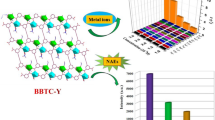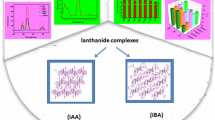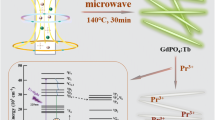Abstract
Luminescent rare earth coordination polymers [H2NMe2]3[Y(DPA)3] ([H2NMe2]+ = dimethyl amino cation; H2DPA = 2,6-dipicolinic acid) are synthesized and is further modified by the ionic exchange reaction of [H2NMe2]+ cation with rare earth ions, which is named as RE3+ ⊂ [Y(DPA)3] (RE = Eu, Tb, Sm, Dy) hybrid systems. The multi-color can be tuned for these functionalized hybrid systems and even white color luminescence can be integrated for Sm3+ ⊂ [Y(DPA)3]. Besides, the fluorescent sensing property of Tb3+ ⊂ [Y(DPA)3] system is checked, which shows high selectivity towards Cr3+ with the concentration of 10−5 mol⋅L−1.







Similar content being viewed by others
References
Ropp RC (2004) Luminescence and the solid state, 2 edn. Elsevier Science, Amsterdam
Kitai A (2008) Luminescent materials and applications. Wiley
Bunzli JCG, Piguet C (2005) Taking advantage of luminescent lanthanide ions. Chem Soc Rev 34:1048–1077
Montgomery CP, Murray BS, New EJ, Pal R, Parker D (2009) Cell-penetrating metal complex optical probes: targeted and responsive systems based on lanthanide luminescence. Acc Chem Res 42:925–937
Haas KL, Katherine J (2009) Application of metal coordination vhemistry yo rxplore and manipulate. Cell Biol Chem Rev 109:4921–4960
de Bettencourt-Dias A (2007) Small molecule luminescent lanthanide ion complexes - photophysical characterization and recent developments. Curr Org Chem 11:1460–1480
Bunzli JCG (2010) Lanthanide luminescence for biomedical analyses and imaging. Chem Rev 110:2729–2755
Eliseeva SV, Bunzli JCG (2010) Lanthanide luminescence for functional materials and bio-sciences. Chem Soc Rev 39:189–227
Sabbatini N, Guardigli M, Lehn JM (1993) Luminescent lanthanide complexes as photochemical supramolecular devices. Coord Chem Rev 123:201–228
Justel T, Nikol H, Ronda C (1998) New developments in the field of luminescent materials for lighting and displays. Angew Chem Int Ed 37:3085–3103
Parker D, Dickins RS, Puschmann H, Crossl C, Howard JAK (2002) Being excited by lanthanide coordination complexes: aqua species, chirality, excited-state chemistry, and exchange dynamics. Chem Rev 102:1977–2010
Batten SR, Champness NR, Chen XM, Garcia-Martinez J, Kitagawa S, Ohrstrom L, O'Keeffe M, Suh MP, Reedijk J (2013) Terminology of metal–organic frameworks and coordination polymers. Pure Appl Chem 85:1715–1724
Novio F, Simmchen J, Vazquez-Mera N, Amorin-Ferre L, Ruiz-Molina D (2013) Coordination polymer nanoparticles in medicine. Coord Chem Rev 257:2839–2847
Binnemans K (2009) Lanthanide-based luminescent hybrid materials. Chem Rev 109:4283–4374
Regulacio MD, Pablico MH, Vasquez JA, Myers PN, Gentry S, Prushan M, Tam-Chang S, Stoll SL (2008) Luminescence of Ln(III) dithiocarbamate complexes (Ln = La, Pr, Sm, Eu, Gd, Tb, Dy). Inorg Chem 47:1512–1523
Huang YG, Jiang FL, Hong MC (2009) Magnetic lanthanide-transition-metal organic-inorganic hybrid materials: from discrete clusters to extended frameworks. Coord Chem Rev 253:2814–2834
Perry JJ IV, Perman JA, Zaworotko MJ (2009) Design and synthesis of metal-organic frameworks using metal-organic polyhedra as supermolecular building blocks. Chem Soc Rev 38:1400–1417
Zhao D, Timmons DJ, Yuan DQ, Zhou HC (2011) Tuning the topology and functionality of metal-organic frameworks by ligand design. Acc Chem Res 44:123–133
O’Keeffe M, Yaghi OM (2012) Deconstructing the crystal structures of metal-organic frameworks and related materials into their underlying nets. Chem Rev 112:675–702
Almeida Paz FA, Klinowski J, Vilela SMF, Tome JPC, Cavaleiro JAS, Rocha J (2012) Ligand design for functional metal-organic frameworks. Chem Soc Rev 41:1088–1110
Cui YJ, Chen BL, Qian GD (2014) Lanthanide metal-organic frameworks for luminescent sensing and light-emitting applications. Coord Chem Rev 273-274:76–86
Roy S, Chakraborty A, Maji TK (2014) Lanthanide–organic frameworks for gas storage and as magneto-luminescent materials. Coord Chem Rev 273-274:139–164
Zhang XJ, Wang WJ, Hu ZJ, Wang GN, Uvdal KS (2015) Coordination polymers for energy transfer: preparations, properties, sensing applications, and perspectives. Coord Chem Rev 284:206–235
Lu Y, Yan B (2014) Lanthanide organic-inorganic hybrids based on functionalized metal-organic frameworks (MOFs) for near-UV white LED. Chem Commun 50:15443–15446
Hao ZM, Song XZ, Zhu M, Meng X, Zhao SN, Su SQ, Yang WT, Song SY, Zhang HJ (2013) One-dimensional channel-structured Eu-MOF for sensing small organic molecules and Cu2+ ion. J Mater Chem A 1:11043–11050
Lu ZZ, Zhang R, Li YZ, Guo ZJ, Zheng HG (2011) Solvatochromic behavior of a nanotubular metal-organic framework for sensing small molecules. J Am Chem Soc 133:4172–4174
Lu Y, Yan B, Liu JL (2014) Nanoscale metal-organic framework as highly sensitive luminescent sensor for Fe2+ in aqueous solution and living cell. Chem Commun 50:9969–9972
Zhou JM, Shi W, Li HM, Li H, Cheng P (2014) Experimental studies and mechanism analysis of high-sensitivity luminescent sensing of pollutional small molecules and ions in Ln4O4 cluster based microporous metal-organic frameworks. J Phys Chem C 118:416–426
Nadella S, Sahoo J, Subramanian PS, Sahu A, Mishra S, Albrecht M (2014) Sensing of phosphates by using luminescent Eu-III and Tb-III complexes: application to the microalgal cell Chlorella vulgaris. Chem Eur J 20:6047–6053
Lu Y, Yan B (2014) A ratiometric fluorescent pH sensor based on nanoscale metal-organic frameworks (MOFs) modified by europium (III) complex. Chem Commun 50:13323–61332
Harbuzaru BV, Corma A, Rey F, Jorda JL, Ananias D, Carlos LD, Rocha J (2009) A miniaturized linear pH sensor based on a highly photoluminescent self-assembled europium(III) metal-organic framework. Angew Chem Int Ed 48:6476–6479
Zhou Y, Yan B, Lei F (2014) Postsynthetic lanthanides functionalization of nanosized metal-organic frameworks for highly sensitive ratiometric luminescent nanothermometers. Chem Commun 50:15235–15238
Gao CJ, Kirillov AM, Dou W, Tang XL, Liu LL, Yan XH, Xie YJ, Zang PX, Liu WS, Tang Y (2014) Self-assembly synthesis, structural features, and photophysical properties of dilanthanide domplexes derived from a novel amide type ligand: energy transfer from Tb(III) to Eu(III) in a heterodinuclear derivative. Inorg Chem 53:935–942
Rao XT, Song T, Gao JK, Cui YJ, Yang Y, Wu CD, Chen BL, Qian GD (2013) A highly sensitive mixed lanthanide metal-organic framework self-calibrated luminescent thermometer. J Am Chem Soc 135:15559–15564
Cui YJ, Xu H, Yue YF, Guo ZY, Yu JC, Chen ZX, Gao JK, Yang Y, Qian GD, Chen BL (2012) A luminescent mixed-lanthanide metal-organic framework thermometer. J Am Chem Soc 134:3979–3982
Zhou Y, Chen HH, Yan B (2014) Eu3+ post-functionalized nanosized metal-organic framework for cation exchange-based Fe3+–sensing in aqueous environment. J Mater Chem A 2:13691–13697
Zhou Y, Yan B (2015) Lanthanides post-functionalized nanocrystalline metal-organic frameworks for tunable white-light emission and orthogonal multi-readout thermometry”. Nanoscale 7:4063–4069
Zhou XH, Li L, Li HH, Li A, Yang T, Huang W (2013) A flexible Eu(III)-based metal-organic framework: turn-off luminescent sensor for the detection of Fe(III) and picric acid. Dalton Trans 42:12403–12409
Hao JN, Yan B (2015) A water-stable lanthanide-functionalized MOF as a highly selective and sensitive fluorescent probe for Cd2+. Chem Commun 51:7737–7740
Kerbellec N, Kustaryono D, Haquin V, Etienne M, Daiguebonne C, Guillou O (2009) An unprecedented family of lanthanide-containing coordination polymers with highly tunable emission properties. Inorg Chem 48:2837–2843
de Melo EF, Santana NC, Bezerra Alves KG, de Sá GF, de Melo CP, Rodrigues MO, Júnior SA (2013) LnMOF@PVA nanofiber: energy transfer and multicolor light-emitting devices. J Mater Chem C 1:7574–7581
Zhang HB, Shan XC, Ma ZJ, Zhou LJ, Zhang MJ, Lin P, Hu SM, Ma E, Li RF, Guo XG, Du SW (2014) A highly luminescent chameleon: fine-tuned emission trajectory and controllable energy transfer. J Mater Chem C 2:1367–1371
He YP, Tan YX, Zhang J (2014) Guest inducing fluorescence switching in lanthanide-tris((4-carboxyl)phenylduryl)amine frameworks integrating porosity and flexibility. J Mater Chem C 2:4436–4441
Duan TW, Yan B (2014) Hybrids based on lanthanide ions activated yttrium metal organic frameworks: functional assembly, polymer film preparation and luminescence tuning. J Mater Chem C 2:5098–5104
Hao JN, Yan B (2014) Amino-decorated lanthanide (III) – organic extended frameworks for multi-color luminescence and fluorescence sensing. J Mater Chem C 2:6758–6764
Sun LB, Xing HZ, Liang ZQ, Yu JH, Xu RR (2013) A 4 + 4 strategy for synthesis of zeolitic metal-organic frameworks: an indium-MOF with SOD topology as a light-harvesting antenna. Chem Commun 49:11155–11157
Gai YL, Jiang FL, Chen L, Bu Y, Su KZ, Thabaiti AA, Hong MC (2013) Photophysical studies of europium coordination polymers based on a tetracarboxylate ligand. Inorg Chem 52:7658–7665
Chen Z, Sun YW, Zhang LL, Sun D, Liu FL, Meng QG, Wang RM, Sun DF (2013) A tubular europium-organic framework exhibiting selective sensing of Fe3+ and Al3+ over mixed metal ions. Chem Commun 49:11557–11559
Ma ML, Ji C, Zang SQ (2013) Syntheses, structures, tunable emission and white light emitting Eu3+ and Tb3+ doped lanthanide metal-organic framework materials. Dalton Trans 42:10579–10586
An JY, Geib SJ, Rosi NL (2009) Cation-triggered drug release from a porous zinc-adeninate metal–organic framework. J Am Chem Soc 131:8376–8377
An JY, Shade CM, Chengelis-Czegan DA, Petoud S, Rosi NL (2011) Zinc-adeninate metal-organic framework for aqueous encapsulation and sensitization of near-infrared and visible emitting lanthanide cations. J Am Chem Soc 133:1220–1223
Shen X, Yan B (2015) Polymer hybrid thin films based on rare earth ion-functionalized MOF: photoluminescence tuning and sensing as thermometer. Dalton Trans 44:1875–1881
Shen X, Yan B (2015) Photofunctional hybrids of lanthanide functionalized bio-MOF-1 for fluorescence tuning and sensing. J Colloid Interface Sci 451:63–68
Mooibroek TJ, Gamez P, Pevec A, Kasunic M, Kozlevcar B, Fu WT, Reedijk J (2007) Efficient, stable, tunable, and easy to synthesize, handle and recycle luminescent materials: [H2NMe2]3[Ln(III)(2,6-dipicolinolate)3] (Ln = Eu, Tb, or its solid solutions). Dalton Trans 39:6483–6487
Zhang HB, Shan XC, Zhou LJ, Lin P, Li RF, Ma E, Guo XG, Du SW (2013) Full-color fluorescent materials based on mixed-lanthanide(III) metal–organic complexes with high-efficiency white light emission. J Mater Chem C 1:888–891
Weng H, Yan B (2016) Lanthanide coordination polymers for multi-color luminescence and sensing of Fe3+. Inorg Chem Commun 63:11–15
Carnall WT, Fields PR, Rajnak K (1968) Electronic energy levels of the trivalent lanthanide aquo ions. III. Tb3+. J Chem Phys 49:4447–4449
Carnall WT, Fields PR, Rajnak K (1968) Electronic energy levels in the trivalent lanthanide aquo ions. I. Pr3+, Nd3+, Pm3+, Sm3+, Dy3+, Ho3+, Er3+, and Tm3+. J Chem Phys 49:4424–4442
Carnall WT, Fields PR, Rajnak K (1968) Electronic energy levels of the trivalent lanthanide aquo ions. IV. Eu3+. J Chem Phys 49:4450–4455
Acknowledgments
This work is supported by the National Natural Science Foundation of China (21571142) and Developing Science Funds of Tongji University.
Author information
Authors and Affiliations
Corresponding author
Electronic Supplementary Material
ESM 1
(DOCX 411 kb)
Rights and permissions
About this article
Cite this article
Weng, H., Yan, B. Multi-Color Luminescence and Sensing of Rare Earth Hybrids by Ionic Exchange Modification. J Fluoresc 26, 1497–1504 (2016). https://doi.org/10.1007/s10895-016-1847-7
Received:
Accepted:
Published:
Issue Date:
DOI: https://doi.org/10.1007/s10895-016-1847-7




